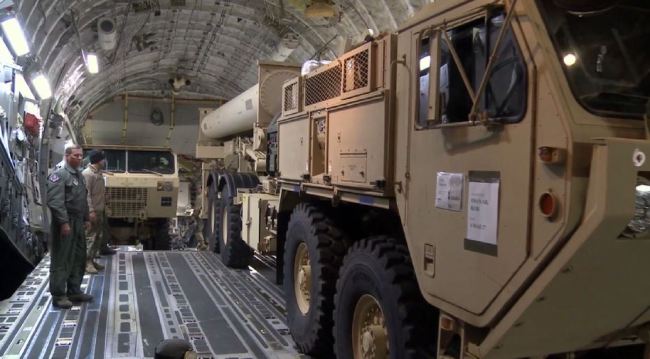In a surprise move, South Korea and the United States began deploying the highly controversial anti-missile system here, just hours after North Korea test-fired ballistic missiles that it said were aimed at US bases in Japan.
The allies confirmed Tuesday that two launchers of the US’ Terminal High Altitude Area Defense system arrived in South Korea’s Osan Air Base late Monday via the C-17 Globemaster III transport aircraft.
They are the first batch of the missile defense system designed to enhance the allies’ capabilities in countering North Korea’s growing missile threats. The deployment will be completed as early as next month, Seoul officials said.
“Continued provocative actions by North Korea, to include yesterday’s launch of multiple missiles, only confirm the prudence of our alliance decision last year to deploy THAAD to South Korea,” US Pacific Commander Adm. Harry Harris said in a statement.
The allies confirmed Tuesday that two launchers of the US’ Terminal High Altitude Area Defense system arrived in South Korea’s Osan Air Base late Monday via the C-17 Globemaster III transport aircraft.
They are the first batch of the missile defense system designed to enhance the allies’ capabilities in countering North Korea’s growing missile threats. The deployment will be completed as early as next month, Seoul officials said.
“Continued provocative actions by North Korea, to include yesterday’s launch of multiple missiles, only confirm the prudence of our alliance decision last year to deploy THAAD to South Korea,” US Pacific Commander Adm. Harry Harris said in a statement.

Consisting of multiple launchers and an advanced radar, THAAD is intended to intercept short- and medium-range ballistic missiles at high altitudes. But its top-notch surveillance capability has unnerved China, which argues the system targets it.
Following the announcement, Beijing voiced its strong opposition to THAAD, warning Seoul and Washington will pay “consequences” for deploying the platform that would undermine its national security.
“We strongly oppose the decision to deploy THAAD and will take necessary steps to defend our security interest,” China’s Foreign Ministry spokesperson Geng Shuang said. “South Korea and the US will bear the consequences. ... We urge them not to go further down that wrong path.”
Fearing that THAAD’s radar may spy deep into its territory, China has been stepping up its retaliatory measures against South Korea, most recently instructing the country’s travel agencies to stop selling tour packages.
Seoul‘s defense and ministries said they did not notify China of the development in advance, highlighting that it was “solely” for the defense of South Korea against the North‘s threats.
South Korea’s acting President Hwang Kyo-ahn and US president Donald Trump spoke on the phone early Tuesday, hours after the arrival of THAAD elements here. They shared the need to sternly deal with the North’s latest launch, casting it as “not only a breach of UN Security Council resolutions, but also a provocation against the international community,” Cheong Wa Dae said.
Trump also highlighted the need for closer bilateral cooperation in coping with North Korea’s military issues, including its missile and nuclear provocations, through in-depth discussions at future two-way high-level meetings.
The newly arrived launchers and other equipment have been transferred to a US military base for a temporary stay until being installed at its site in Seongju, North Gyeongsang Province, Seoul’s Defense Ministry said, declining to elaborate on its current location due to security concerns.
The move came as the allies are quickening the deployment process in part to minimize any potential setbacks due to political uncertainties in South Korea, which is expected to hold a presidential election within a few months. Seoul’s military acquired land to host the battery last month from Lotte Group and is now in consultations with the US Forces Korea over its handover.
But the ministry refused to provide a detailed deployment schedule and how many launchers will be stationed eventually, citing security concerns. A THAAD battery is comprised of six truck-mounted launchers, 48 interceptors, a fire control and communications unit and an AN/TPY-2 radar, but the one in the US’ Guam base has four launchers.
Ministry officials also ruled out the possibility for the new system would be employed during the joint annual military exercises. They have said the allies would apply an operational guideline to counter North Korea’s nuclear and missile facilities including the use of THAAD for the Key Resolve computer-simulated drills scheduled to kick off next week.
“The THAAD batteries did not come here to participate in the combined exercise,” said an official from the Combined Forces Command. “The deployment process has just begun.”
By Yeo Jun-suk (jasonyeo@heraldcorp.com)






![[From the Scene] Monks, Buddhists hail return of remains of Buddhas](http://res.heraldm.com/phpwas/restmb_idxmake.php?idx=644&simg=/content/image/2024/04/19/20240419050617_0.jpg&u=20240419175937)





![[Graphic News] French bulldog most popular breed in US, Maltese most popular in Korea](http://res.heraldm.com/phpwas/restmb_idxmake.php?idx=644&simg=/content/image/2024/04/18/20240418050864_0.gif&u=)


![[From the Scene] Monks, Buddhists hail return of remains of Buddhas](http://res.heraldm.com/phpwas/restmb_idxmake.php?idx=652&simg=/content/image/2024/04/19/20240419050617_0.jpg&u=20240419175937)

![[KH Explains] Hyundai's full hybrid edge to pay off amid slow transition to pure EVs](http://res.heraldm.com/phpwas/restmb_idxmake.php?idx=652&simg=/content/image/2024/04/18/20240418050645_0.jpg&u=20240419100350)

![[Today’s K-pop] Illit drops debut single remix](http://res.heraldm.com/phpwas/restmb_idxmake.php?idx=642&simg=/content/image/2024/04/19/20240419050612_0.jpg&u=)